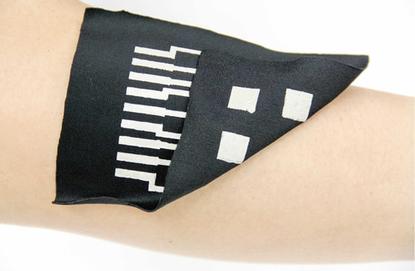Super-stretchable smart fabrics could enable new wearables
- 25 June, 2015 20:05

Japanese researchers said June 25, 2015, that they have made a prototype wrist band muscle activity sensor using functional ink that can maintain high conductivity while being stretched. The band has a muscle activity sensor that was produced by printing on each side of the flexible material’s surface.
Engineers in Japan are making conductive inks that can be stretched to the extreme, adding to research on smart fabrics by Google, NTT and other groups in one sign of the possible future direction of wearables.
The researchers printed electrodes and wires on a prototype wrist band made of stretchable sportswear textile. The device can act as a muscle sensor, but the technology could also be used for applications such as underwear that monitors a user's heart rate.
The prototype is an organic transistor amplifier circuit, which measures muscle electrical potentials through nine electrodes arranged in a square grid. The key element, though, is a new functional ink that is highly conductive, stretchable and printable in a single-step process using a metal or plastic stencil.
Elastic conductors are usually made by mixing conductive fillers and rubber, but conductivity drops when the ink is stretched. The new ink is made of silver flakes, organic solvent, fluorine rubber and fluorine surfactant. The surfactant allows the silver flakes to self-assemble on the surface of the printed ink, giving it high conductivity even when stretched to more than three times its original length.
That could be significant for sportswear materials, which are often stretched to a high degree as athletes move. A smart material with such elasticity could be used for sports applications such as monitoring vital signs in athletes during a competition.
The conductor has the highest conductivity of any elastic conductor that can be stretched to more than two and a half times its original length, the researchers from the University of Tokyo, Japan Science and Technology Agency and other centers wrote in a Nature Communications article published Thursday. However, the conductor has to be made more robust and washable before it can be commercialized.
The Japanese researchers believe that clothing embedded with printed, flexible electronics is the next step in consumer electronics that have gone from tabletop computers to mobile devices to wearables such as the Apple Watch. Google's Project Jacquard is also focused on smart fabrics, but using them as a control device for nearby electronics. Mobile carrier NTT DoCoMo and chemical company Toray Industries have also explored clothing with conductive nanofibers to measure heart rate.
"A fabric that can extract an electrocardiogram just by putting it on has already put into practical use," Takao Someya, a professor of engineering at the University of Tokyo who led the research into the new ink, said via email.
"However, this doesn't mean that smartphones, smartwatches and smartglasses will disappear. Simply, electronic clothing will add one more attractive layer of diversity."
Tim Hornyak covers Japan and emerging technologies for The IDG News Service. Follow Tim on Twitter at @robotopia.
